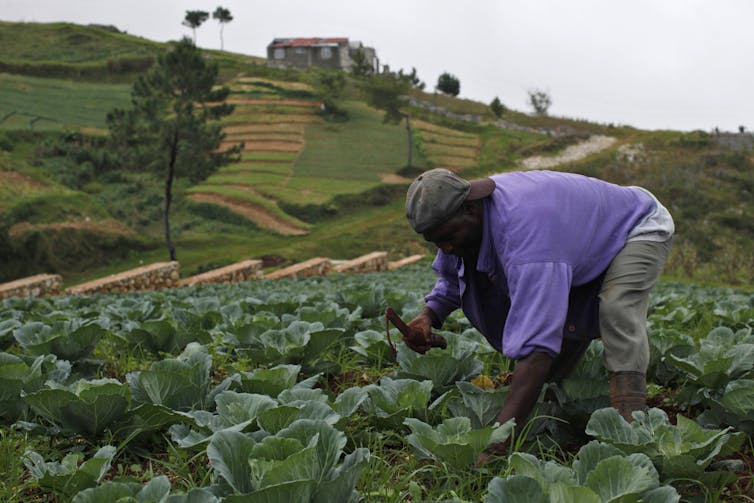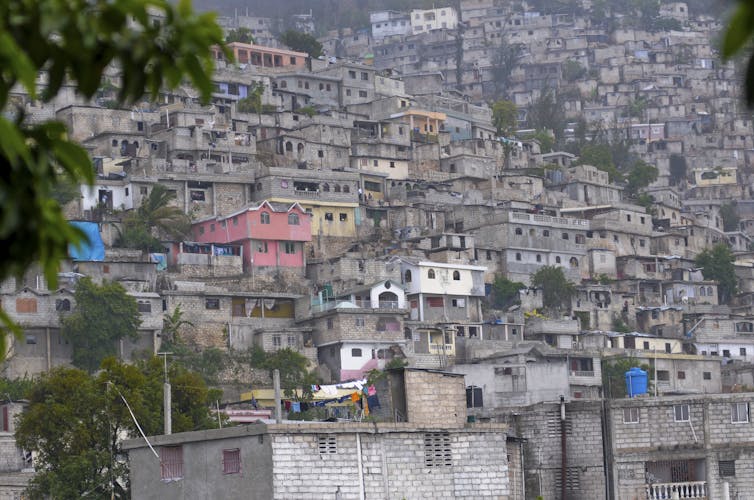In Haiti, climate aid comes with strings attached
- Written by Keston K. Perry, Postdoctoral researcher, Fletcher School of Law & Diplomacy, Tufts University
Perhaps no people[1] know better than Haitians just how dangerous, destructive and destabilizing climate change can be.
Haiti – which had not yet recovered from a massive 2010 earthquake when Hurricane Matthew[2] killed perhaps a thousand people and caused a cholera outbreak in 2016 – is one of the world’s most vulnerable countries[3] to climate change.
Scientists say extreme weather events like hurricanes, floods and droughts will become worse as the planet warms. Island nations[4] are expected to be among the hardest hit by those and other impacts of a changing climate, like shoreline erosion.
For poor island countries like Haiti, studies show[5], the economic costs, infrastructural damage and loss of human life is already overwhelming[6]. And scientists expect it will only get worse.
To help Haiti address this pending crisis, international donors have stepped in with funding for climate action. The problem with that system, as I found in a recent analysis of international climate aid in Haiti[7], is that the money may not be going where it’s most needed.
Extreme vulnerability
Though Haiti’s greenhouse gas emissions amount cumulatively to less than 0.03 percent of global carbon emissions[8], it is a full participant in the 2015 Paris climate agreement[9] and has committed to reduce its greenhouse gas emission by 5 percent by 2030.
To meet that goal, Haitian officials say, the Caribbean country must switch 1 million traditional light bulbs for more efficient LED bulbs, grow 137,500 hectares of new forest and shift 47 percent of its electricity generation to renewable sources. Those are just a few objectives in Haiti’s 2015-2030 climate plan[10].
 Almost a fifth of Haiti’s population works in agriculture. To achieve climate resilience, farmers must still be able to feed people even after a disaster.
Reuters/Eduardo Munoz[11]
Almost a fifth of Haiti’s population works in agriculture. To achieve climate resilience, farmers must still be able to feed people even after a disaster.
Reuters/Eduardo Munoz[11]
It needs help to meet them.
Haiti is among the poorest countries in the Western Hemisphere. Nearly 60 percent of the population lives on less than US$2.41 per day, according to the country’s 2012 household survey[12], the most recent poverty data available.
More than 20 percent of its national budget[13] is funded by loans from the World Bank and the International Monetary Fund – a setup that gives international lenders an unusual level of control over Haiti’s government expenditures[14].
The same is true of Haiti’s climate mitigation efforts[15]. The majority of the money behind its 15-year plan to finance climate mitigation and adaptation activities – from disaster preparation and renewable energy development to increasing food security – also comes from international donors.
The crowdsourced nature of Haiti’s climate budget can make it hard to determine just how much money Haiti has to spend – and what, exactly, the government can spend it on.
So, last year, I worked with the Climate Policy Lab at the Fletcher School at Tufts University to analyze Haiti’s climate budget.
A hodgepodge of climate funding
In an unpublished 2018 study, we found that the World Bank and Inter-American Development Bank are the two biggest donors to Haiti’s $1.1 billion climate fund. Switzerland is also a major financier, having given the Caribbean nation $64.4 million since 2009, as is Japan, which has given $14.8 million to help fund Haiti’s climate efforts.
Most of this $1.1 billion comes in the form of grants, not loans – it’s free money. And, in a country with a gross domestic product of $8 billion, $1.1 billion for climate mitigation is a substantial sum of money.
However, as my recent analysis of the Tufts climate study shows[16], the bulk of the money appears to be misallocated.
Numerous international donors, each of which has set its own climate objectives, fund climate action in the country. The result, I found in my analysis, is that Haiti’s climate budget is a mashup of donor priorities that puts too much money behind certain initiatives while underfunding other environmental needs.
Fully 70 percent of Haiti’s $1.1 billion climate budget – $773 million – is earmarked for making energy production more sustainable in Haiti. This involves improving hydroelectric power and increasing solar usage, among other energy upgrades.
Renewable energy may have seemed like a sensible priority for the World Bank and other individual donors. But, put together, this is a disproportionately high investment for a country with such low carbon emissions[17], my analysis shows. My research suggests the money could be better used to connect more Haitians to the energy grid. Currently, just 20 percent of Haitians[18] – most of them in Port-au-Prince – have semi-reliable electricity. Power is a necessity after any disaster.
Reforestation projects are also notably absent in Haiti’s climate budget.
Haiti is the Caribbean’s most deforested nation[19]. Seventy percent of forests[20] on the island have disappeared since the late 1980s. It desperately needs reforestation projects to reduce flooding, coastal erosion and water pollution[21] and prevent mudslides.
Yet in my analysis of the total $116 million in donor funds earmarked for watershed management and soil conservation, I found barely a mention of reforestation.
 Hillside neighborhoods like this area outside Port-au-Prince are prone to mudslides during heavy rain.
Reuters/Swoan Parker[22]
Hillside neighborhoods like this area outside Port-au-Prince are prone to mudslides during heavy rain.
Reuters/Swoan Parker[22]
Mismatch between perception and reality
Other areas of Haiti’s climate change plan are somewhat better funded but, to my mind, misguided.
Take disaster risk reduction, for example. Of the $269 million earmarked for reducing disaster risk in Haiti, most funds are set aside for rebuilding after disasters.
That may seem sensible in a country prone to earthquakes, flooding and hurricanes, but research shows that sustainable construction[23] – not merely rebuilding – better prepares a country for disasters and other long-term effects of climate change. Planning saves time, energy, money and human life.
Haiti’s international donors have set aside little money for ensuring that new highways, buildings and other critical infrastructure in Haiti are constructed in a resilient, climate-ready manner – before the next big disaster happens.
Addressing the power imbalance
This kind of mismatch between local needs and donor priorities is a common hazard of internationally funded budgets.
Donors call the shots about how their money is spent from afar. Often they don’t have enough on-the-ground information to be making such important executive decisions.
In interviews, local Haitian officials told me[24] that the municipal agencies that actually engage with people and communities have little say over how they may spend climate funds or which environmental projects are implemented.
In Haiti, this problem is not limited to climate funding – it’s a hazard of running a national government[25] on the largess of other countries.
Last year, the International Fund for Agricultural Development, a United Nations donor agency, announced a community-based strategy[26] to building climate resilience in Haitian agriculture by partnering with local organizations and agencies.
“This community-based approach will support Haitians working together[27] to enhance their economic potential, resilience and coping strategies when faced with climatic and economic shocks,” a 2018 report said.
My climate research in Haiti supports this assessment.
If international donors allow Haitian authorities more control over funding, working more closely with local community organizations, they would not only help address its most important needs, the strategy would be cost-effective. Money channeled to where Haiti most needs it is money well spent.
References
- ^ no people (www.theguardian.com)
- ^ Hurricane Matthew (theconversation.com)
- ^ most vulnerable countries (reliefweb.int)
- ^ Island nations (www.undp.org)
- ^ studies show (www.oxfam.org)
- ^ is already overwhelming (www.germanwatch.org)
- ^ recent analysis of international climate aid in Haiti (environment.harvard.edu)
- ^ less than 0.03 percent of global carbon emissions (www.climatelinks.org)
- ^ the 2015 Paris climate agreement (unfccc.int)
- ^ 2015-2030 climate plan (www4.unfccc.int)
- ^ Reuters/Eduardo Munoz (pictures.reuters.com)
- ^ the country’s 2012 household survey (www.worldbank.org)
- ^ 20 percent of its national budget (www.cfr.org)
- ^ over Haiti’s government expenditures (theconversation.com)
- ^ Haiti’s climate mitigation efforts (www.oxfam.org)
- ^ my recent analysis of the Tufts climate study shows (environment.harvard.edu)
- ^ such low carbon emissions (www.iied.org)
- ^ 20 percent of Haitians (www.bu.edu)
- ^ most deforested nation (earther.gizmodo.com)
- ^ Seventy percent of forests (www.sciencedirect.com)
- ^ reduce flooding, coastal erosion and water pollution (psmag.com)
- ^ Reuters/Swoan Parker (pictures.reuters.com)
- ^ sustainable construction (www.unenvironment.org)
- ^ told me (environment.harvard.edu)
- ^ it’s a hazard of running a national government (journals.openedition.org)
- ^ announced a community-based strategy (www.ifad.org)
- ^ will support Haitians working together (webapps.ifad.org)
Authors: Keston K. Perry, Postdoctoral researcher, Fletcher School of Law & Diplomacy, Tufts University
Read more http://theconversation.com/in-haiti-climate-aid-comes-with-strings-attached-108652


